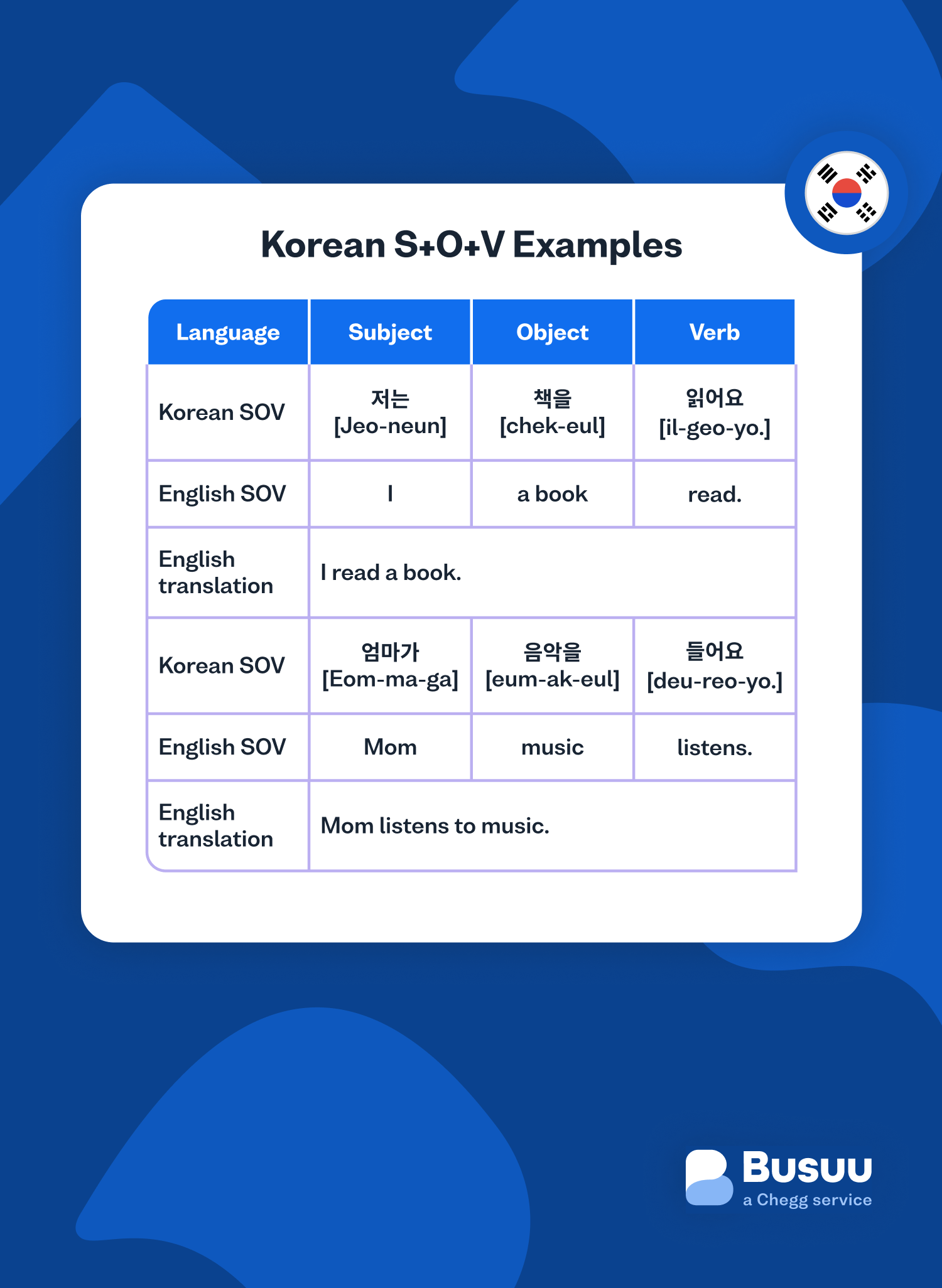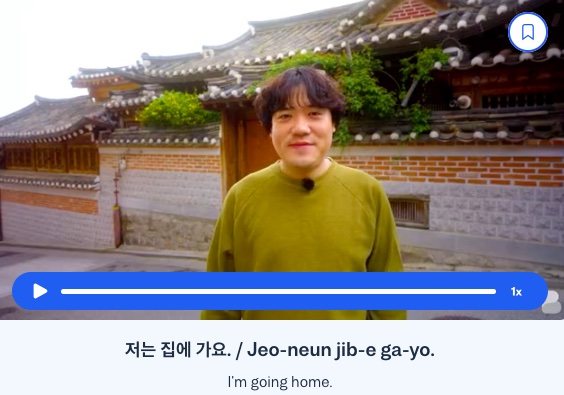Korean Sentence Structure: The Complete Guide
Let’s learn about the Korean sentence structure and master how to form different types of sentences!
I want to learn...
Korean sentence structure can be a little confusing depending on how your first language works. The word order of Korean sentences is different from English, declarative statements and question statements look the same, and many Korean sentences seem incomplete and missing keywords.
In this article, we will guide you through the major features of Korean sentences so that you have a clear understanding of how Korean sentences are formed.
The basic Korean sentence structure
The basic sentence structure of many languages is a subject and a verb, and this is also the case in Korean.
Sentence Type 1 - Subject + Verb (S+V)
| Subject | Verb |
|---|---|
| 저는 [Jeo-neun] |
자요. [ja-yo.] |
| I | sleep. |
| 민수가 [Minsu-ga] |
먹어요. [meo-geo-yo.] |
| Minsu | eats. |
In Korean, we often use particles with the sentence subject, so in the first sentence, 저 means ‘I’ and 는 is a particle. Similarly, in the second sentence, 민수 means ‘Minsu’, and 가 is a particle. However, the word order of the most basic Korean sentence structure is ‘Subject + Verb’ (S+V) - it’s the same as English sentences.
If we add the object of the verb, the word order of Korean sentences is different from English.
Sentence Type 2 - Subject + Object + Verb (S+O+V)
| Subject | Object | Verb |
|---|---|---|
| 민수가 [Minsu-ga] |
사과를 [sa-gwa-reul] |
먹어요 [meo-geo-yo.] |
| Minsu | an apple | eats. |
| Minsu eats an apple. |
In Korean, the object of the verb 사과 (apple) is between the subject and the verb, and this differs from English as the object is always positioned after the verb in English (Minsu eats an apple).
When we use objects, they are often used with object marking particles 을/를. We use 을 with nouns that end in a final consonant, such as 책 (book) which ends in the final consonant ㄱ, so we say 책을. However, with nouns ending in vowels, such as 사과 which ends in the vowel ㅘ, we use 를 and say 사과를.

S+O+V Examples
| Subject | Object | Verb |
|---|---|---|
| 저는 [Jeo-neun] |
책을 [chek-eul] |
읽어요 [il-geo-yo.] |
| I | a book | read. |
| I read a book. | ||
| 엄마가 [Eom-ma-ga] |
음악을 [eum-ak-eul] |
들어요 [deu-reo-yo.] |
| Mom | music | listens. |
| Mom listens to music. |
Expanding the sentence
Quite often, we want to add more information in our sentences, so we want to say where or when something happens, where we go to, or who we do something with, and we can do that by using phrases like ‘at home’, ‘to school’, or ‘with my friend’. These phrases are called prepositional phrases in English. Let’s first take a look at an example sentence.
Sentence Type 3 - Additional information
| Subject | Prep. phrase | Object | Verb |
|---|---|---|---|
| 민수가 [Minsu-ga] | 학교에서 [hak-gyo-e-seo] | 사과를 [sa-gwa-reul] | 먹어요 [meo-geo-yo.] |
| Minsu | at school | an apple | eats. |
| Minsu eats an apple at school. |
In this sentence, we have the phrase 학교에서 meaning ‘at school’. 학교 means ‘school’, and 에서 is a particle and we use it to talk about something happening at a specific location, and in this sentence, we use 학교에서 to describe where Minsu eats an apple - at school.
In this sentence, the position of 학교에서 is before the object of the verb 사과를. However, the position of the two parts can change in Korean, so we can also say…
Sentence Type 3 - Additional information
| Subject | Object | Prep. phrase | Verb |
|---|---|---|---|
| 민수가 [Minsu-ga] |
사과를 [sa-gwa-reul] |
학교에서 [hak-gyo-e-seo] |
먹어요 [meo-geo-yo.] |
| Minsu | an apple | at school | eats. |
| Minsu eats an apple at school. |
In the above sentence, 학교에서 (at school) has changed positions with 사과를 (an apple), and whenever this happens, we are putting more emphasis on the part that’s next to the verb, so in this sentence, the focus of the sentence is on where Minsu eats an apple, rather than what he eats.
However, a sentence can have multiple parts to show additional meaning.
Sentence Type 3 - More additional information
| Subject | Prep. phrase | Prep. phrase | Object | Verb |
|---|---|---|---|---|
| 민수가 [Minsu-ga] |
학교에서 [hak-gyo-e-seo] |
친구랑 [chin-gu-rang] |
사과를 [sa-gwa-reul] |
먹어요 [meo-geo-yo.] |
| Minsu | at school | with a friend | an apple | eats. |
| Minsu eats an apple at school with a friend. |
So we’ve added 친구랑 (with a friend), and this is positioned after 학교에서 (at school). However, the same sentence can be written in many different ways, with the order of the prepositional phrases and the object of the verb changing.
Here are examples:
- 민수가 친구랑 사과를 학교에서 먹어요.
- 민수가 학교에서 사과를 친구랑 먹어요.
- 민수가 사과를 친구랑 학교에서 먹어요.
As you can see, regardless of the order of the three phrases in the middle of the sentence, the sentence is grammatically correct and the meaning is also the same. However, in general, we emphasize the phrase that’s closest to the verb, so the first sentence emphasizes 학교에서 (at school) more and the second sentence emphasizes 친구랑 (with a friend) more. Nevertheless, while the position of the phrases can change, the subject is usually at the beginning of the sentence and the verb is always at the end of the sentence.
Understanding 이다
이다 is essentially a particle, but it functions like a verb, and we can use it like the English verb ‘to be’ and say sentences like ‘I am a teacher’, or ‘Minsu is a friend’.
Sentences that use 이다
| Subject | Complement | 이다 |
|---|---|---|
| 저는 [Jeo-neun] |
선생님 [seon-saeng-nim] |
이에요. [i-e-yo.] |
| I | a teacher | am |
| I am a teacher. |
이다 can be changed into different levels of formality, but regardless of the conjugated form of 이다, when 이다 is used in a sentence, it’s always attached to the complement (noun), so we write 저는 선생님이에요 and NOT 저는 선생님 이에요 - there should not be space between 선생님 (a teacher) and 이에요 (am).
이다 has two polite forms - 예요 & 이에요. We use 예요 if the noun ends in a vowel, so we use 예요 with 친구 (friend) as 친구 ends in the vowel ㅜ. However, 선생님 (teacher) ends in the consonant ㅁ, so we say 선생님이에요.
Example sentences that use 이다:
- 저는 김예지예요. [Jeo-neun Kim-Yeji-ye-yo.] - I am Yeji Kim.
- 민수는 친구예요. [Minsu-neun chin-gu-ye-yo.] - Minsu is a friend.
- 내일이 제 생일이에요. [Nae-il-i je saeng-il-i-e-yo.] - Tomorrow is my birthday.
Korean adjectives
Korean adjectives function like verbs, so they take up the same position as verbs in a sentence, and they can be conjugated into different tenses. However, just like English adjectives, their main function is to describe nouns, most commonly the sentence subject.
Here’s an example English sentence that uses an adjective:
- This is good.
In this sentence, the subject is ‘This’, the verb is ‘is’, and the adjective is ‘good’ and the adjective describes the subject ‘This’.
Here’s the same sentence in Korean:
- 이거 좋아요. (I-geo jo-a-yo.)
In this sentence, 이거 means ‘this’, and 좋아요 is the adjective and this word not only means ‘good’, but it also includes the meaning of the verb ‘is’, so 좋아요 means ‘is good’. Because Korean adjectives act like a verb and an adjective, we often call them ‘descriptive verbs’.
One other important point to note is that Korean adjectives are not used to describe actions, so they can never have an object - like verbs that describe actions.
Example sentences that use Korean adjectives.
- 날씨가 더워요. [Nal-ssi-ga deo-wo-yo.] - The weather is hot.
- 가방이 비싸요. [Ga-bang-i bi-ssa-yo.] - The bag is expensive.
- 저는 피곤해요. [Jeo-neun pi-gon-hae-yo.] - I am tired.
- 고양이가 예뻐요. [Go-yang-i-ga ye-ppeo-yeo.] The cat is pretty.
Korean questions
The conjugated form of the verb or the adjective is different depending on speech level. Let’s take the verb 가다 (to go) as an example.
Different speech levels of 가다
| Speech level | Declarative form | Question form |
|---|---|---|
| Formal | 갑니다 | 갑니까 |
| Polite | 가요 | 가요 |
| Casual | 가 | 가 |
The formal form of 가다 is different for declarative statements and question statements. For declarative statements, it’s 갑니다, but for questions, it’s 갑니까. However, for the polite form and the casual form, the conjugation of 가다 is the same regardless of whether we are forming declarative statements or question statements.
Questions and statements (formal speech)
| Sentence type | Korean | English |
|---|---|---|
| Declarative Statement | 진수는 학교에 갑니다. [Jinsu-neun hak-gyo-e gam-ni-da.] |
Jinsu goes to school. |
| Question Statement | 진수는 학교에 갑니까? [Jinsu-neun hak-gyo-e gam-ni-kka?] |
Does Jinsu go to school? |
Between the declarative statement and the question statement, the only difference is the final syllable - it’s either ‘다’ or ‘까’. However, as with English, when we ask questions in Korean, we have to raise the tone at the end. In contrast, declarative statements are said with a falling tone at the end.
Example questions that use verbs and adjectives in formal form:
- 음악을 좋아합니까? [Eum-ak-eul jo-a-ham-ni-kka?] - Do you like music?
- 민수는 집에 있습니까? [Minsu-neun jib-e i-sseum-ni-kka?] - Is Minsu at home?
- 강아지가 예쁩니까? [Gang-a-ji-ga ye-ppeum-ni-kka?] - Is the dog pretty?
Questions and statements (polite speech)
| Sentence type | Korean | English |
|---|---|---|
| Declarative Statement | 진수는 학교에 가요. [Jinsu-neun hak-gyo-e ga-yo.] |
Jinsu goes to school. |
| Question Statement | 진수는 학교에 가요? [Jinsu-neun hak-gyo-e ga-yo?] |
Does Jinsu go to school? |
To make verbs and adjectives into casual forms, we simply remove 요 at the end of the polite form, and similar to the questions that use verbs and adjectives in their polite form, the declarative statement and the question statement are exactly the same. Like the sentences that use verbs and adjectives in polite form, declarative statements are said with a falling tone at the end, but question statements are said with a rising tone at the end.
Omitting known information
In Korean, particularly in speech, if certain information is known to both the speaker and the listener, then that information can be omitted from the sentence. Here’s a common question people ask each other in Korean.
Omitting the sentence subject
| Subject | Object | Verb |
|---|---|---|
| - | 점심 [Jeom-sim] |
먹었어요? [Meo-geo-sseo-yo?] |
| - | lunch | ate? |
| Did you eat lunch? |
In Korean, when we direct a question to someone, we often omit the pronoun ‘you’ as the other person will implicitly understand that the question is about them. However, as well as questions being directed at someone, if we know who or what the question is about, we often omit the sentence subject.
So if we are talking about a certain dish, and we want to ask whether that dish is delicious, we would just ask…
- 맛있어요? [Ma-si-sseo-yo]? - Is it delicious?
And 맛있어요 is the polite form of 맛있다 (to be delicious), so to ask ‘Is it delicious’, we simply use the adjective 맛있어요 (to be delicious), and we can omit the subject ‘it’.
Going back to the question ‘Did you eat lunch?’, after someone has asked 점심 먹었어요? (Did you eat lunch), we often reply by saying…
- 네, 먹었어요. [Ne, meo-geo-sseo-yo.] - Yes, I ate.
In this sentence 네 means ‘yes’, and 먹었어요 means ‘ate’, so all we are basically saying is ‘Yes, ate’. We don’t need to say that ‘I’, and we don’t need to say we ate 점심 (lunch). All of these things are understood based on the context.
Recap on Korean sentence structure
So in this article, we went over:
- Word order: SVO (English) Vs. SOV (Korean)
- Use of different phrases and the changing order of these phrases
- Use of 이다
- Use of Korean adjectives (descriptive verbs)
- Korean questions
- Omitting known information
To improve your understanding of these concepts and your ability to use Korean sentences, it’s important for you to practice using Korean and to read and hear Korean sentences regularly, so why not head over to the Busuu app, and start using Korean today!
Want to know more Korean?
We’re Busuu, the language-learning app – and we’ve helped thousands learn Korean. Level up with help from free online courses crafted by language experts, support from our community of 120+ million native speakers, and more.

